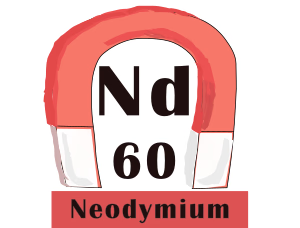Neodymium
Neodymium is a rare earth metal. Neodymium magnets are super powerful magnets. Explore what makes Neodymium special and why it has excellent magnetic properties.

Neodymium (Nd) is a Rare Earth Metal.
"Rare Earth Metals" are a group of 17 elements. Even though their name says rare, they are quite plentiful on Earth. They are rarely found alone. They occur scattered and mixed with other elements in certain types of rocks.
These rocks contain minerals like silicates, carbonates and phosphates. Extracting Neodymium and other rare earth metals from rocks is a complex process.
Neodymium Uses
NEODYMIUM, (and other rare earth metals) are used to make parts for hi-tech devices. NEODYMIUM, is used in lasers, microphones, loud speakers, DC motors, computer hard disks and electric generators.
Neodymium glass is made by adding Neodymium oxide during glass making. It is an exquisite glass that changes colors under different lighting conditions (normal daylight, incandescent and
flourescent lights).
Neodymium Magnets
Neodymium magnets are strong enough to attract 1000 times their own weight. Small Nd magnets weighing 10 grams can lift 1 kilo weights.
A lot of magnetic power is packed in to a small neodymium magnet. They have strong magnetic fields, very sensitive to changes. Nd magnets convert small changes in magnetic field to sound waves,
making them the preferred choice for manufacturing loudspeakers and head phones.
Their strong magnetic power makes them a good choice for heavy applications like generators in air crafts, wind turbines and motors in electric vehicles.
Mining Neodymium
Most of the Neodymium today is mined in China. China has imposed restrictions on exporting it to other countries, making it available for local manufacturing industries. This has made industries outside China look for alternatives. Iron Nitride and Cerium may become future replacements for Neodymium.
More on Nd
DISCOVERY :
Isolated & named by:
Carl Auer von Welsbach, 1885, Austria
PERIODIC TABLE : Fourth member of Lanthanides.
MELTING POINT : 1,021 C
ATOMIC NUMBER : 60
